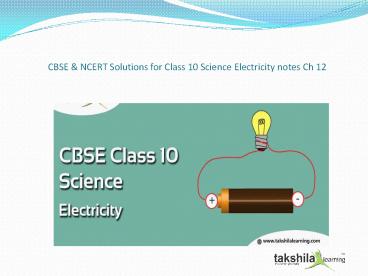CBSE & NCERT Solutions for Class 10 Science Electricity notes Ch 12 - PowerPoint PPT Presentation
Title:
CBSE & NCERT Solutions for Class 10 Science Electricity notes Ch 12
Description:
CBSE & NCERT Solutions for Class 10 Science Electricity notes Ch 12. NCERT Solutions for Class 10 Science (Physics) Chapter 12 - Electricity solved by Expert Teachers as per NCERT (CBSE). Now, the first question arises in the mind of the 10 Class Science student, can we live without electricity? The answer is ‘No – PowerPoint PPT presentation
Number of Views:6579
Title: CBSE & NCERT Solutions for Class 10 Science Electricity notes Ch 12
1
CBSE NCERT Solutions for Class 10 Science
Electricity notes Ch 12
2
CBSE NCERT Solutions for Class 10 Science
Electricity notes Ch 12
- Class 10 Science Electricity In this article,
we will discuss an important topic from Class 10
Science Electricity notes. - Now, the first question arises in the mind of
the 10 Class Science student, can we live without
electricity? The answer is No. - What is Electricity?
- Electricity is an important source of energy in
the modern times. It is used in our homes for
lighting, operating fans, trains, etc. The
ability to attract anything is called electric
charges. - Electric charges
- It has been scientifically proven that the
electric charges are of two types- positive
charges and negative charges. The charge acquired
by a glass rod is called positive charge and the
charge acquired by an Ebonite rod is called
negative charge. - Lets discuss the property for electric charges
are - Opposite charges attract each other.
- Similar charges repel each other.
3
CBSE NCERT Solutions for Class 10 Science
Electricity notes Ch 12
- The SI unit of electric charge is Coulomb which
is denoted by the letter C. All the matter around
positively charged particles called protons and
negatively charged particles called electrons. - A proton possesses a positive charge of 1.6 X
Whereas electron possesses a negative charge 1.6
X . - Conductors and Insulators
- A conductor is a substance through which
electricity can flow. Eg- Silver, copper,
aluminum, etc. - Insulators are the substances through which
electricity cannot flow are called insulators.
Eg- Glass,Ebonite, rubber, etc. - Moving forward, now understand how the conductors
work? - All the conductors have some electrons which are
loosely held by the nuclei of their atoms. These
electrons are called Free electrons and can
move from one atom to another atom throughout the
conductor. The presence of free electrons in a
substance makes it a conductor. - Electricity can be divided into two parts-
- Static electricity-In this electrifying, the
electric charges remain at rest as they do not
move. - Current electricity-In this electrifying, the
electric charges are in The electricity we use it
in our homes is called current electricity.
4
CBSE NCERT Solutions for Class 10 Science
Electricity notes Ch 12
- Electric Potential
- Work done in moving a unit positive charge from
infinity to a point is called the electric
potential at that point in an electric field. - The potential is denoted by the symbol V and
its unit is volt. - Potential Difference
- The amount of work done in moving a unit charge
from one point to the other point is defined as
the potential difference between two points. - Potential difference work done/quantity of
charged moved. - The SI unit of potential difference is volt and
which is denoted by the letter V. - The potential difference between two points is
said to be 1 volt if 1 joule of work is done in
moving 1 coulomb of electric charge from one
point to the other. - 1 volt1joule/1coulomb
5
CBSE NCERT Solutions for Class 10 Science
Electricity notes Ch 12
- The potential difference is measured by means of
an instrument called aVoltmeter. A voltmeter has
a high resistance so that it takes a negligible
current from the circuit. Voltage is the other
name for potential difference. - In the next article, we will discuss the further
topics of Class 10 Science Electricity. Keep
watching the space for more. - Follow Us on Social Media
6
CBSE NCERT Solutions for Class 10 Science
Electricity notes Ch 12
- Clear your doubts on an hourly basis with experts
of Science, click live classes for Class 10
Science to know more. - A complete learning module for Biology,
chemistry, and physics through virtual videos is
a perfect solution for study at home. For free
demo visit www.takshilalearning.com































